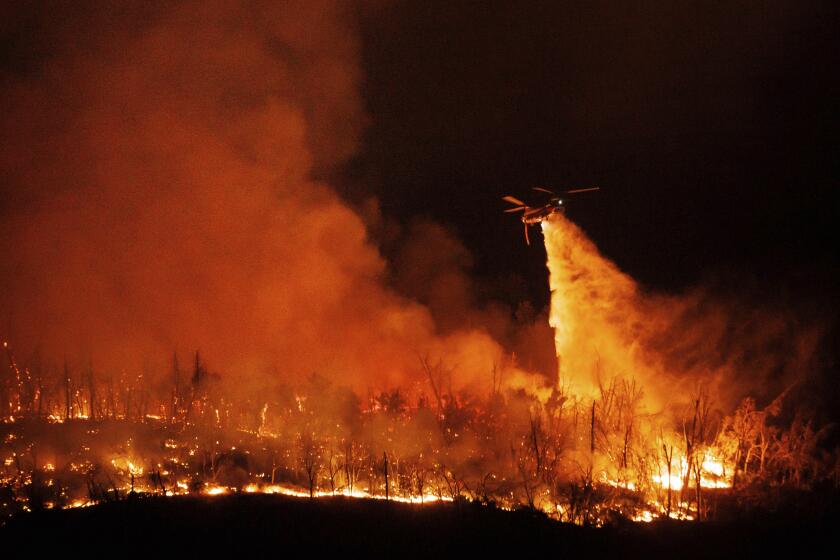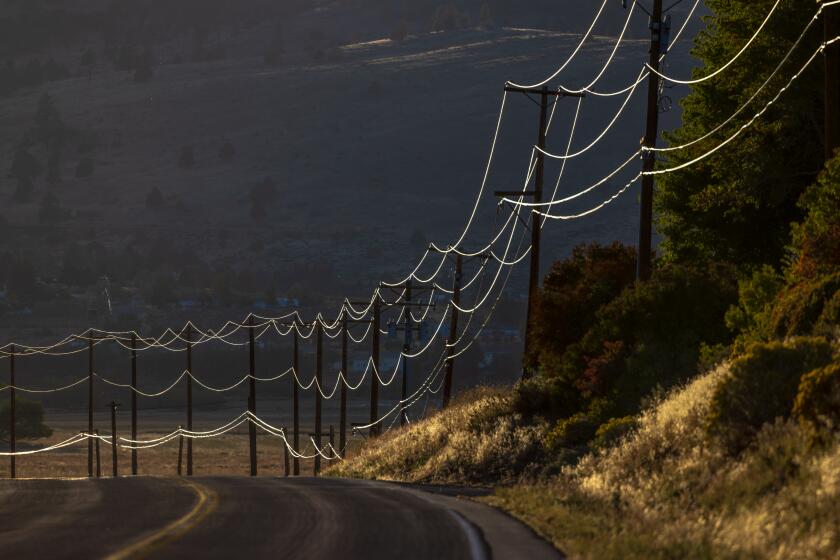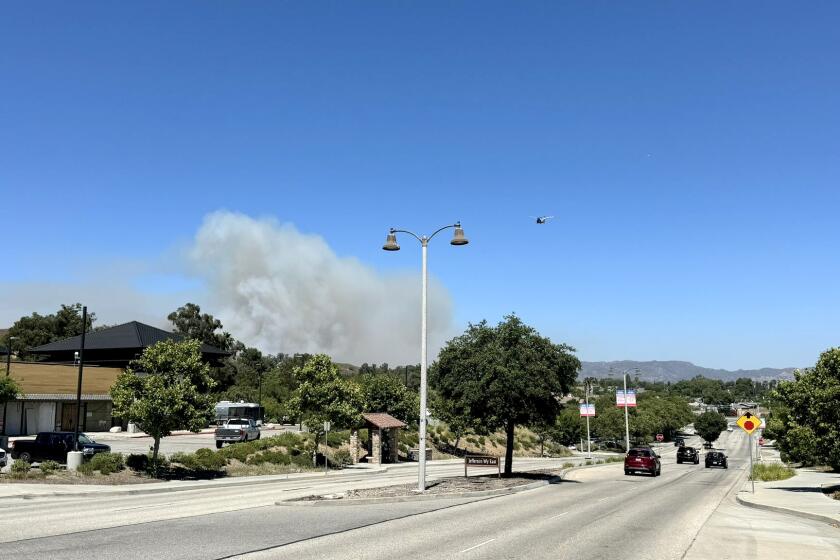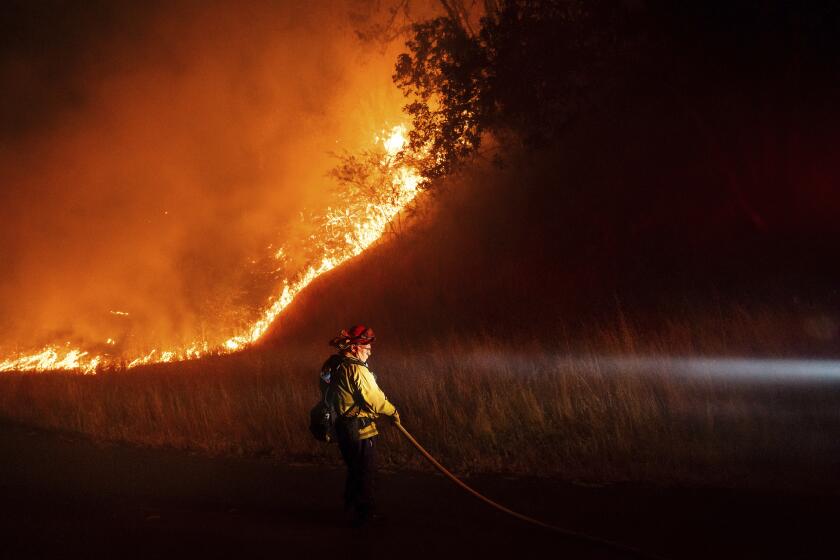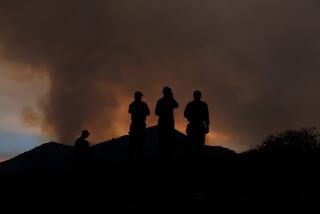California burns as heat wave spreads across western U.S.
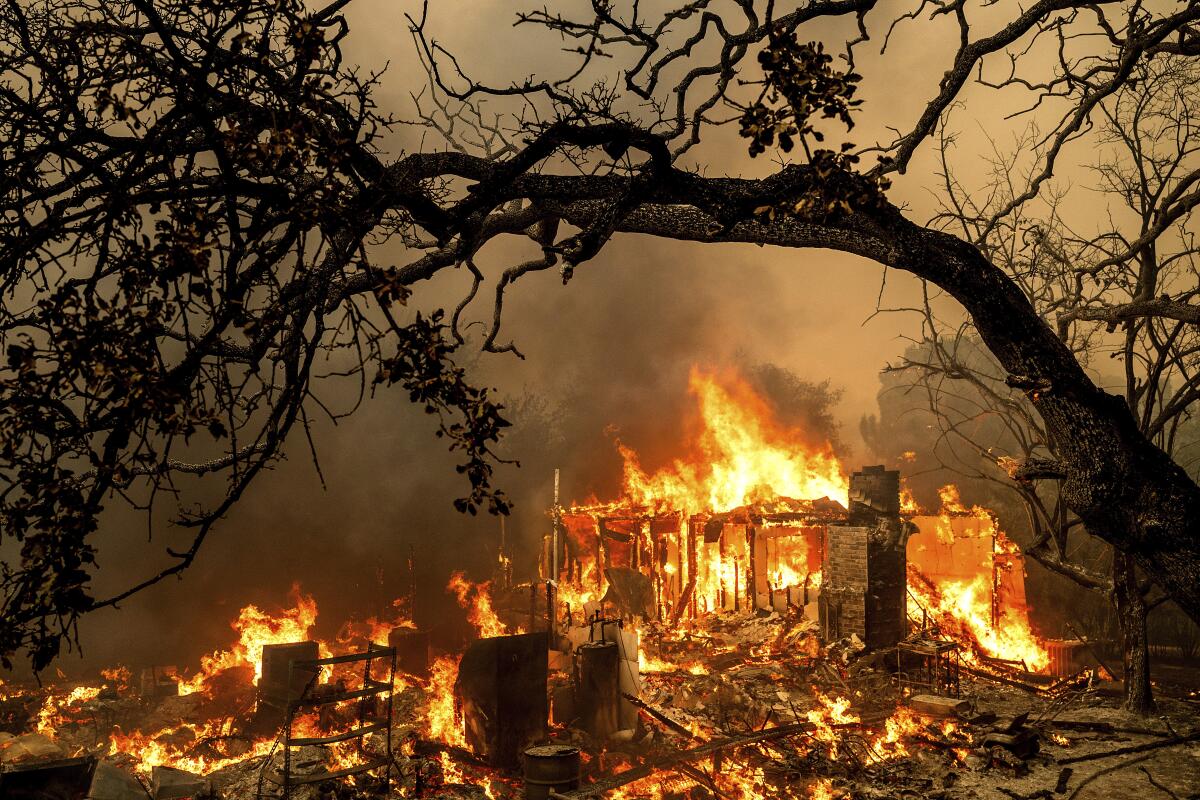
- Share via
OROVILLE, Calif. — Firefighters are continuing to battle wildfires across the state as Californians brace for triple-digit temperatures and a dangerous, prolonged heat wave that’s forecast to stretch into next week.
The most concerning blaze Wednesday was the Thompson fire burning in the city of Oroville in Butte County, where several structures were destroyed and thousands evacuated as flames pushed closer to communities.
A brush fire was also threatening homes in Lower Lake, prompting evacuations.
Gov. Gavin Newsom declared a state of emergency for the Thompson fire on Wednesday, noting that it was threatening “structures, homes, critical infrastructure, and health and congregate care facilities.”
“We are using every available tool to tackle this fire and will continue to work closely with our local and federal partners to support impacted communities,” Newsom said in a statement.
The Thompson fire tripled in size overnight from 1,000 acres to more than 3,500 acres Wednesday afternoon and was at 7% containment by Wednesday evening, according to officials with the California Department of Forestry and Fire Protection. The blaze was spreading in two directions: north into more rural territory and south toward additional homes and businesses. More than 1,400 personnel were working on the blaze.
Eight firefighters have been injured. Four sustained minor heat-related injuries Tuesday, and one suffered an unspecified injury on the fireline Wednesday, said Rick Carhart, a public information officer with Cal Fire’s Butte County unit. Three firefighters were hospitalized Wednesday morning after their fire engine crashed: two with minor injuries and one with moderate injuries, he said.
The winds from the north have continued to push the flames toward Kelly Ridge, a heavily populated neighborhood east of Lake Oroville where most of the evacuees live, Carhart said.
Among them were Don and Linda Pederson, who said they wouldn’t be run out by the latest fire to encroach on their property.
“It’s not the first time this has happened,” said Don, 81.
But it’s the closest a fire has come to their home of 50 years, which sits on an acre lot east of Oroville Dam that’s been in Linda’s family since 1945. He said he thinks the fire, at its closest, was about a mile away, but that they don’t plan to evacuate unless it crosses Highway 162.
The Pedersons’ home is in an evacuation warning area, although he said the fire map puts his garage squarely in the mandatory evacuation zone.
“The line goes through my house,” he said with a chuckle. “Even if our whole house was in the evacuation zone, we would not leave unless I knew it was on our side of the road and coming down the hill.” He added that they have power and, as a backup, a whole-house generator.
“Yesterday, I could actually see flames in the distance,” he said. “We did not evacuate, even though they have law enforcement going up and down the street with loudspeakers and going door-to-door saying, ‘Get out.’ But we chose to stay.”
He said he was currently monitoring the fire with his wife, Linda, 79, from inside their home, with a few essential papers set aside in case they need to leave quickly. Their lot is mowed down to create a defensive space to ward off traveling embers, he said, and their two vehicles are parked away from their home in case it catches fire. There are two fire hydrants next to their property.
“The breeze is not real strong, but it is picking up right now,” he said. “And I have seen quite of bit of smoke.”
Initially, the Feather River halted the fire’s progress to the south from where it started at Cherokee Road and Thompson Flat Road, but as the fire grew in strength, it managed to jump the river.
“This fire burned in a mixture of both grass and heavy brush,” Carhart said. “The fire [spread] across by flying embers that flew across the water and then landed on the other side.”
The combination of grass, which burns quickly, and brush, which stokes longer flame lengths — helping to throw embers ahead of the flame front — contributed to the quick and early growth of the fire, Carhart said.
Officials say that, at one point, about 12,000 homes, businesses and other buildings were threatened, and 28,000 people were told to leave their homes. That was before some evacuation orders were downgraded to warnings Wednesday evening, Carhart said, although an updated tally wasn’t immediately available.
High temperatures and dried vegetation are creating difficult conditions for firefighters across California. The Thompson fire is in Butte County.
At least four homes have been destroyed.
“Incidentally, there are a number of people in the area that moved [to Kelly Ridge] after getting burned out at the Camp fire,” Carhart said, referring to the 2018 fire that killed 85 people and destroyed more than 18,000 buildings, the deadliest and most destructive wildfire on record in California.
On Wednesday, the Thompson fire was burning near a dense area of housing, which added an additional layer of challenges, Carhart said. Many firefighters were pulled to structure protection — staging in driveways to make sure embers didn’t ignite homes.
Crews have been fighting the fire under excessive-heat and red-flag warnings.
With California’s grueling heat wave, temperatures were forecast to reach up to 113 degrees Thursday and top out on Saturday at 114 in Oroville. Winds gusts Wednesday were around 15 to 20 miles per hour near the fire.
The relative humidity around the fire Wednesday was below 20%, with overnight recovery expected in the mid-30s to low 40s, according to meteorologist Kate Forrest in the National Weather Service’s Sacramento office.
It’ll start to cool down, relatively, starting Monday, with forecast temperatures between 107 and 109 degrees.
“It is unusual to see heat of this magnitude so early in July with temperatures 10 to 20 degrees higher than normal,” she added.
Hot weather coincides with extreme fire conditions across Northern California, prompting Pacific Gas & Electric Co. to initiate the first public safety power shutoffs of the year. Even so, the region has seen several wildfires ignite.
The heat wave could potentially break the record of seven consecutive days of high temperatures above 105 degrees in downtown Sacramento, Forrest said. Daily temperature records could also be broken at Sacramento International Airport and in Redding.
For the Los Angeles region, high temperatures over the next week in the San Fernando Valley are expected to range from 100 to 108 degrees, while it could reach the low 90s in downtown Los Angeles and around 80 near the beaches, according to weather service meteorologist Mike Wofford.
Temperature records for the date could be broken on Friday in Woodland Hills (which has a current July 5 record of 106 degrees), Burbank (104), Los Angeles International Airport (85) and Long Beach (91), Wofford said.
It’s expected to start cooling down Sunday into Monday, but temperatures are still forecast to be in the triple digits in the valleys and in the high 80s in downtown Los Angeles.
“This heat wave stands out due to its length,” Wofford added. “A lot of times, we’ll get heat waves that will last two, three, four or five days, but this one will stretch on seven or eight days, particularly across the interior areas. It’s the duration that’s notable.”
Record-breaking and dangerous heat is not only hitting California and the West this Fourth of July week, but also broiling the southern Plains and Mid-Atlantic, with 110 million people in 21 states under a heat advisory, watch or warning, the weather service’s Weather Prediction Center said in a Wednesday morning forecast.
Much of Northern California remains under a red flag warning — an alert for extreme fire weather — due to a combination of winds up to 30 mph, low humidity and high temperatures that “can contribute to extreme fire behavior,” according to the weather service.
The Federal Emergency Management Agency said in a statement Wednesday that it had approved federal funds for assistance in fighting the Thompson fire.
Crews in Butte County also fought three separate smaller vegetation fires nearby, the largest of with grew to seven to eight acres before firefighters stopped its spread, Carhart said.
“It’s hot and it’s dry and you have to be careful out here because it is very, very easy for fires to start and spread in conditions like this,” he said. “We already have our hands full with a big fire in our unit, and we don’t need a bunch of other smaller fires kicking up.”
Given the conditions across its coverage area, Pacific Gas & Electric Co. initiated its first public safety power shutoffs of the year, affecting just over 2,000 customers across eight counties — Butte, Colusa, Lake, Napa, Solano, Sonoma, Tehama and Yolo. The shutoffs, which began Tuesday, lasted through noon Wednesday, according to the utility. The move is meant to prevent the utility’s equipment from sparking fires during dangerous conditions.
In Simi Valley, the Sharp fire ignited around 1:47 p.m. in the hills off Sharp Road, spurring an evacuation order for homes along Ditch Road that was lifted by 6:15 p.m., said Andrew Dowd, public information officer with the Ventura County Fire Department. One firefighter was hospitalized with minor heat-related injuries, he said.
The fire, mapped at 133 acres as of Wednesday evening, was 15% contained, he said.
The Sharp fire was reported at 1:47 p.m. Wednesday in the hills off Sharp Road near Ditch Road in Simi Valley, according to the Ventura County Fire Department.
Evacuations were ordered in Lower Lake, in Lake County, after a fire engulfed a commercial building and spread into grass and oak woodland, threatening homes. The Adams fire, which started in the 16200 block of Main Street around 3:09 p.m., was 15 acres and 15% contained as of 5:30 p.m., said Jason Clay, public information officer with Cal Fire’s Sonoma-Lake-Napa Unit.
“We have a control line around the perimeter of the fire,” he said, “and firefighters will be on scene for another four or five hours as they’re doing heavy mop-up operations to address hot spots inside the perimeter of the fire.”
Even though the unit had sent three engines to the Thompson fire, it was able to get a handle on the Adams fire with a strong initial attack, in unified command with the Lake County Fire Protection District, he said.
In Napa County, the Toll fire began north of Calistoga just before 10 a.m. Tuesday and grew to about 40 acres, according to Cal Fire.
The wind-driven fire closed at least one road in the area and prompted several evacuation orders and warnings, affecting just over 100 people, according to Clay. By Wednesday evening, crews had managed 40% containment of the fire.
The conditions in the area are ripe for further wildfires to erupt, Clay said. Two consecutive wet winters stoked a heavy grass crop, prompting the National Interagency Coordination Center to last week issue an advisory warning of the potential for rapid fire spread in California’s grass-dominated ecosystems, including deserts and dry valleys where the vegetation usually isn’t sufficient to support fire growth.
“The grasses are really dry,” said Clay, who noted the area’s red flag warning. “That combination is all aligning, [and] that could lead to extreme fire behavior.”
Fire officials have continued to warn that once vegetation fully dries out — typically by midsummer — wildfires could ramp up, given the profusion of grass and brush that grew after two winters with heavy precipitation.
California wildfires burned almost 90,000 acres already this year, an amount more than five times the average of pre-summer blazes from the last few years.
In eastern San Diego County, another large fire continued to grow after starting Monday. The McCain fire, burning just off Interstate 8, was 70% contained Wednesday evening, having scorched 1,595 acres, according to Cal Fire. The fire had prompted multiple evacuation orders and warnings, affecting about 140 people, according to Mike Cornette, a fire captain with the San Diego County Cal Fire team.
California’s longest heat wave of the year, bringing triple-digit temperatures, fire danger and air quality concerns, is expected to arrive Tuesday.
The cause of the fire is still under investigation, but Cornette said it was probably sparked by a traffic collision that caused a vehicle to become engulfed in flames. He said about 150 structures were threatened, but none had been damaged.
Two other small fires also sparked Tuesday in Northern California: The Denverton fire in Solano County and the Yolla fire in Shasta County were both less than 30 acres as of Wednesday night.
Crews also were still fighting the Basin fire Wednesday, which had burned 13,979 acres in the Sierra National Forest in Fresno County. It was 26% contained, according to Cal Fire.
That blaze is burning not far from the Balch Camp, an isolated community from which more than 150 people were evacuated because of the flames. PG&E has power infrastructure there, but a spokesperson for the utility said none of its facilities had been affected as of Tuesday morning.
Times staff writer Gutierrez reported from Oroville and Toohey, Mejia, Lin and Deng from Los Angeles. Times staff writers Joseph Serna, Rachel Uranga and James Rainey contributed to this report.
More to Read
Sign up for Essential California
The most important California stories and recommendations in your inbox every morning.
You may occasionally receive promotional content from the Los Angeles Times.
